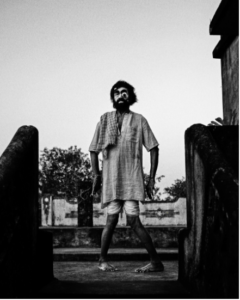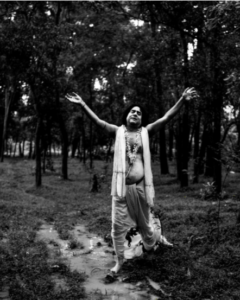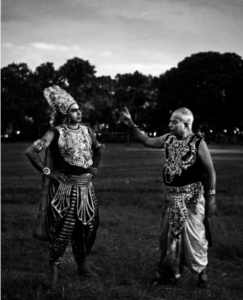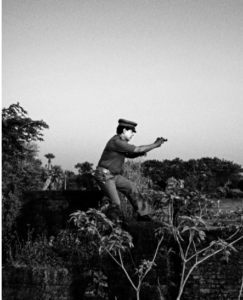Preserving an art from in monochrome, Soumya Sankar Bose’s exhibition ensures the future generations are provided a window to its colourful past
For photographer Soumya Sankar Bose, documenting the fast fading art form Jatra, was quite personal. Moving out of his hometown in Midnapore, West Bengal, he returned after a decade in 2013 to learn of his uncle’s retirement from Jatra.
Due to the lack of money and growing disinterest in this style of folk theatre, his uncle had to retire to take up employment with a railway factory. The genre caught his interest and he sought to seek the stars of the bygone days
“Growing up I had seen a lot of Jatra and whatever I know of mythology is mostly from it. Even my granduncles were actors in Jatra, so I started by asking if there were any more people like them who are now retired, but were gigantic figures in Jatra at one time,” says Bose.




Capturing the essence of Jatra through the perspective of the once popular actors, his works are on display at an online exhibition of black and white photographs. Presented by Experimenter, this exhibition is a part of the third edition of an online series – In Touch.
“This solo exhibition by photographer Soumya Sankar Bose, is showing a sensitive body of photographs titled, Let’s Sing An Old Song, that takes root in Bose’s personal relationship with the folk theatre practice – Jatra. As Bose brings to life these once revered actors in his photographs, he not only refers to a sense of nostalgia but also his immersion in the relationships he has built with the individuals he photographs, who in turn seem to have cast their own lives within the characters they have embodied on stage for decades,” says Prateek Raja, director of Experimenter
Bose began his journey by tracking the actors who are spread across the state. He describes the process of tracing them as “interesting but difficult”. Since many of them do not own phones, he could not get the proper address, but only the village names from different Jatra groups and production houses.
He would travel to the village and ask around for their exact address. While he found 60% of his case studies, there were cases where he was unable to locate them. Hence it took him almost four years to complete the series. Starting from Midnapore he travelled across the Odisha-West Bengal border, Hooghly and Bangladesh to document them.
Most Jatra artists live in villages and small towns and not in Kolkata because the city is a bit expensive for them to live in post-retirement.
Bose started meeting them individually, listening to their stories, the various characters they played in the 50’s, 60s and 70s. He photographed them at their best, dressed as the characters they were most fondly known for. From getting the costumes, renting their props and sometimes even making them, when unavailable, his photographs give us a glimpse of what was once celebrated.
With 12 of his works on display, he shares that he has intentionally kept them all in monochrome. “I realised that the major archives in their albums or online, and videos are all in black and white. There are no colour photographs of them, because the time Jatra was famous, the colour photography was not introduced in India,” adds Bose.
The archives feature in his works as well, so he merges the works in order to give the feeling of being lost both in the past and present. Bose consciously documented them in black and white grainy format, to give that feel.
The one thing that struck Bose the most in the process of documentation is that, it just wasn’t the art form that got lost in time but also the artists.
“When I met those artists in 2013, all of them were from the 70s-80s. After that people from our generation, their families, they almost forgot that their grandparents were very famous figures in Jatra, and that people used to know them really well. Nobody now cares or knows about them. Hence, they never really expected that after 30-40 years someone would come to them and spend time with them because they had a glorious past. This gave them some kind of satisfaction, which in turn was also satisfying for me.”
Nobody in their family practises Jatra procession anymore because it ceased to exist. It only takes place as a seasonal theatre like during the times of Durga Puja.
While it is not financially viable to continue practising this dying art form, Bose admits that the least he can do is to preserve them. From various cut-outs, posters and archives, he has digitised everything that he could preserve, and is planning on publishing this soon.
“Everything has its own time and after that it automatically fades away. Then the only thing we can do is document it for the future generations. Jatra had its time, but it’s over. It’s hard to accept it. Just like single screen theatres are becoming a thing of the past.”
The exhibition can be viewed at the website of Art In Touch till September 15
(Cover: Soumya Sankar Bose captured the Jatra artists in their costumes )





